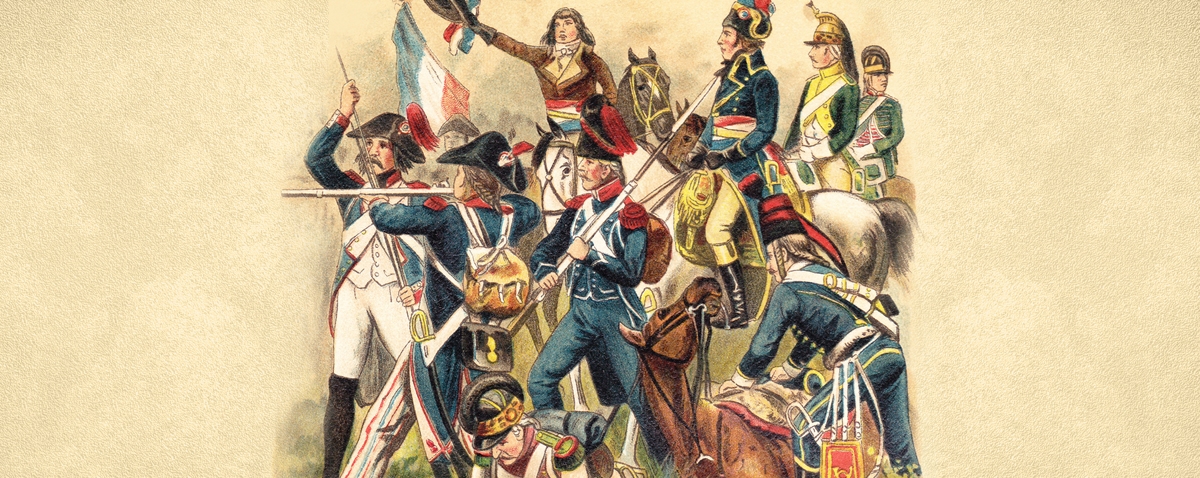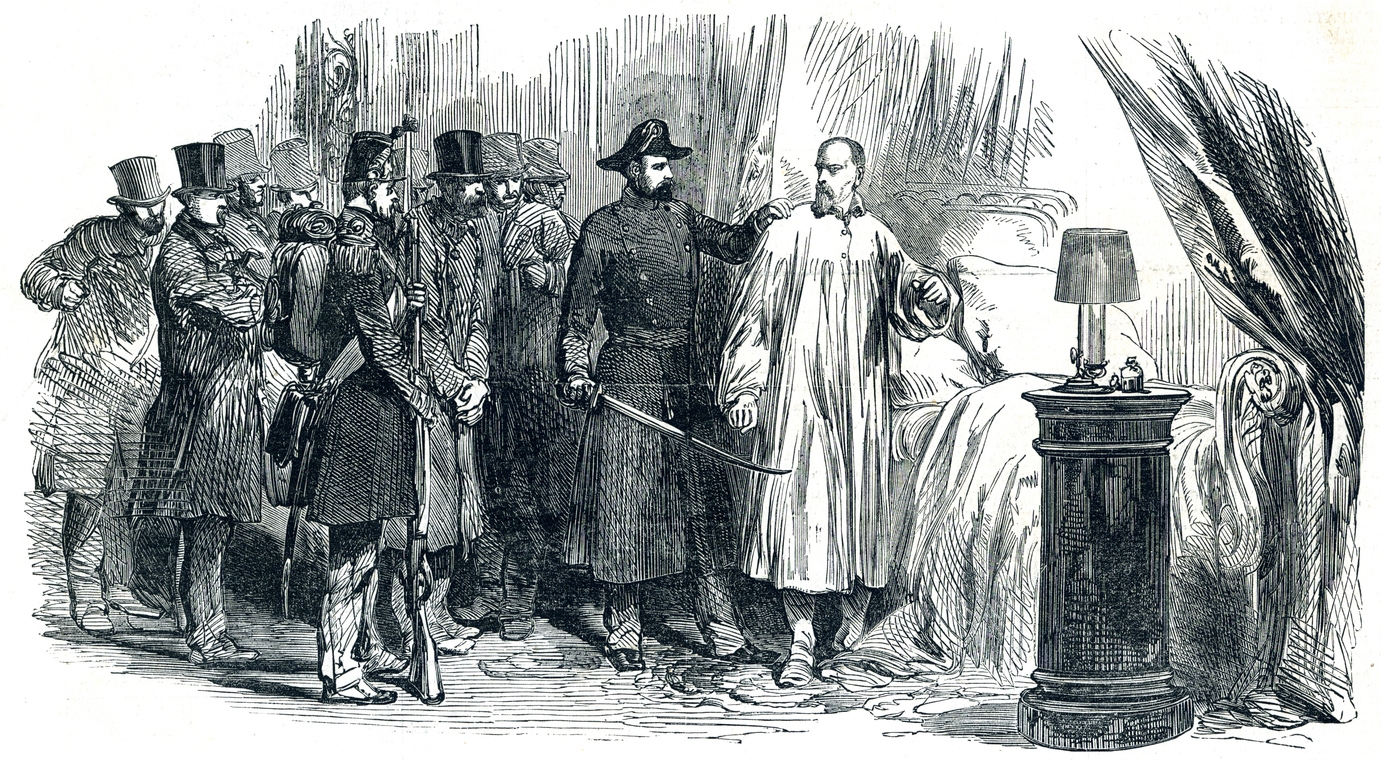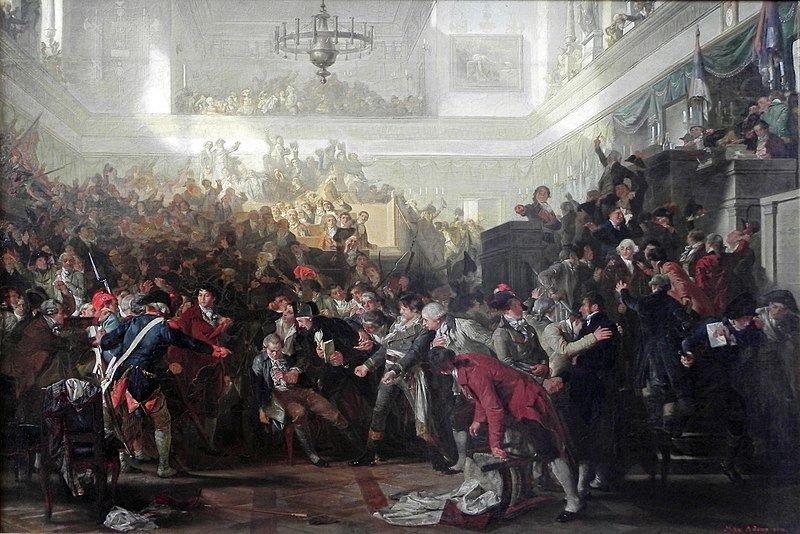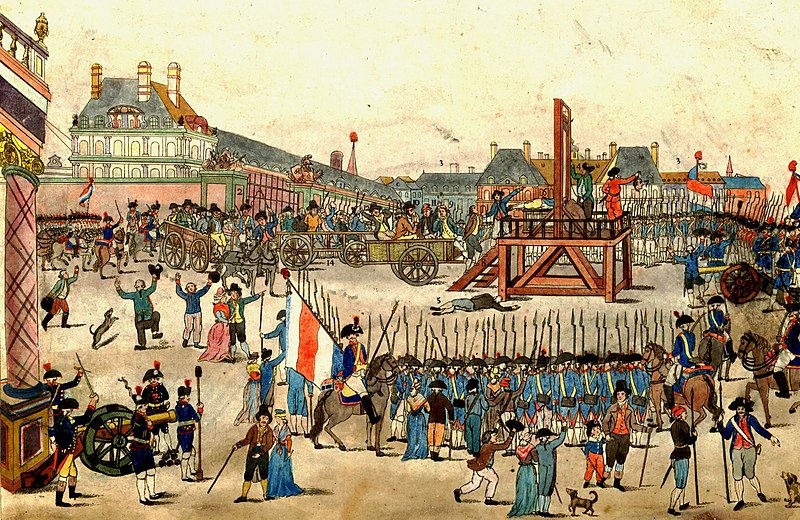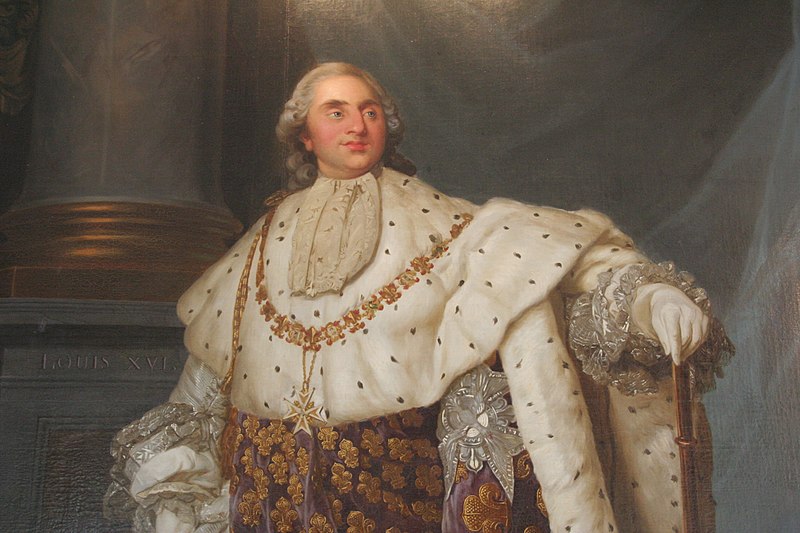Table of Contents
People have the power to bring a change for better or for worse! Time and again humans have proven how their puissance to bring a change had rattled the governments, brought authorities on their knees and caused havoc. And what could be a better exemplification of this than the French Revolution that started in 1789 and altered France forever. [1]
What started as a spark to rebel against the atrocities of the monarchs soon became the fire that devoured many who initiated it. From the Rebellion to the Reign of Terror, the revolution exhibited the authority and rage of the people, but if anything, it has paved the way for democracy across the globe. The timeline of the French Revolution started immediately after the American revolution, for people of France suffered because of the decision of their ruler to help America.
This mutiny of people though courageous and justified, also highlighted how too much of anything can do more harm than good. The rebellion that was initiated to free the common man became his most grisly prison in the shape of Reign of Terror – the blood-soaked period of French Revolution, where even the slight disagreement against the revolution resulted in being guillotined. The rebellion became the unsatiated hunger that took many lives, irrespective of the status of the person or the reason of the opinion one holds.
Why the Mutual Rebellion Turned into a Reign of Terror?
The French Revolution ignited in the community a sense of their rights. As simple as it seems, overthrowing the aristocratic feudal regime was not a simple task considering the fact that the monarchs were considered as someone appointed by the god to rule. But eventually, the will to change and the suppression due to poverty resulted in civil mutiny by the people against their monarch.
Though what could have been a joyous era was soon turned into a mayhem when Reign of Terror was imposed by Maximilien Robespierre on 5th September 1793. [2] While Robespierre was responsible for most of the bloodshed, he was not the sole cause to make the reign of Terror a norm. In fact, several factors played their role to get the genie out of the bottle.
Threat of Foreign Invasions
The French succeeded in going against their own ruler, though this was a victory of the people, the aristocracy in the neighboring countries saw it as a warning sign to keep a tight hold on their own people. To curb the revolution, Louis XVI shook hands with monarchs of Prussia and Austria, thus the Pillnitz Declaration was signed. [3] The sole purpose was to aid Louis XVI in retaining his powers back into France.
As a result, a war broke out between the bourgeoisie of France and the Austro-Prussians. While defeat seemed inevitable, the French were warned against harming Louis XVI. Several defeats sowed seeds of fear among the masses, resulting in some doubting the idea of revolt against the monarchs. In order to test the loyalty of the people, the government decided on the guillotine fervor.
Enlightenment and The Havoc It Caused
Despite the fact that enlightenment in its true sense is the freedom to have one voice in matters of concern, the leaders of the French Revolution had other ideas. For them the government was the sovereign with the most virtues and morale, someone who knew the best in the interest of the people. Anyone who would even act on his/her “Social Contract” by expressing his/her right or had reservation to any rule or law of the revolt would be considered as a rebel and “tyrant”, resulting him/her being executed publicly with the merciless guillotine.
Popular Pressure
The ardor of the revolution began to lose its charm when the internal fights between the conservative and the radical parties started. The Convention was further forced to upgrade the poor, failing to do so would result in the wrath of the sans-culottes. [4] This holier-than-thou attitude of the working class added fuel to the already ongoing fights within the government. To curb the internal resistance and avoid the popular pressure, the government took Reign of Terror as their only refuge.
When Religion Became the Target
Although people in their entirety wished to live in a more equitable society whereby they had the freedom to question authority, seek their answers through rationality and science, they were not willing to give up on their religious practices. The Revolution, nonetheless, managed to rob religious bodies of their unnecessary authorities, appreciate free thinking with logic and give power to the people through the government; it could not completely shun the sentiments of the people pertaining to their beliefs.
This “forceful” need of the government to completely eradicate religious sentiments resulted in the people going against the government. This clash gave leaders in government another excuse to use the guillotine to hush hush the noises around them. After all, the government was not prepared to let people go against their wishes.
Beginning of the Reign of Terror
Post revolution, when France was attacked by invaders who saw the revolt as a threat, a committee by the name of “French Comité De Salut Public, was formulated. Comprising 12 members in total, this committee that was established in April 1793, was to maintain and safeguard France and to ensure accountability of the new government. [5] The members selected by National Convention would be appointed for one month and if needed, could be reelected.
The Committee of Public Safety
Initially headed by Georges Danton and his followers, the committee was later handed over to Maximilien Robespierre and his team for their determination and strong inclination to uplift the spirit of revolution. What was established to take radical measures became a dictatorial body that would operate solely on instilling fear and unrest among people.
Democracy suddenly seemed like a far-fetched idea and it was in 1794 when Robespierre was executed that the committee too lost most of its autonomy. Some significant members who were part of the committee were Louis de Saint-Just, Maximilien Robespierre, George Couthon and Lazare Carnot.
The Law of Suspects
The newly established government and the committee soon started suspecting the citizens for their disloyalty towards the revolution that became almost sacred to them. Anyone who dared to express his/her concerns would be seen in a negative light and would become the target. In order to ensure loyalty to the cause and to rule out traitors, the Law of Suspect was introduced on 17th September, 1793. [6]
The law stated that
- Post publication of the Law of Suspect, all suspects within France would be put behind bars.
It further defined suspects as being
- Anyone who had their biases against freedom and had made a comment or showed interest in federalism through their action.
- Anyone who was not considered patriotic by their actions.
- Anyone was not able to perform their assigned civic duties as was described in the decree of 21 March.
- All civil servants that were suspected by the National Convention or its commissioners, mainly those who were removed from their duties due to decree of 14th August.
- All the nobles and their families who did not accept the French Revolution.
- Those who escaped between 1st July 1789 and 8th April 1792 and later returned.
The Guillotine
The reign of terror was inflicted by the mass execution of all the suspects by the device known as the Guillotine. [7] Made by the surgeon and named after him, the device was used before as well to carry out capital punishment in European countries but for France it became the symbol of death in 1792.
With its sharp blade or knife supported with two upright posts, the blades were deliberately weighed heavily to ensure immediate death with least pain to the victim or criminal. The same device became the cause of death of thousands of people including the much-loathed King Louis XVI, Marie Antoinette
Though Reign of Terror was the only time it was widely used, it took 189 years for France to completely abolish its use by ending capital punishment in September 1981.
Maximilien Robespierre: The Good, The Bad, The Ugly
While many names get highlighted when it comes to the French Revolution, one name that tops the list is that of Maximilien Robespierre. His obsession with the revolution earned him many fiends and adversaries. During his reign, more than 17,000 people were decapitated by guillotine but the same device that he recklessly encouraged to be used wrote his fate too after he was arrested along with his 21 devotees.
The Revolutionary
Born in 1758 in Arras, he was an educated individual who pursued law on scholarship and by 1789, became the representative of the people of Arras in the Estate General. [8] Post the conversion of the Third Estate to the National Assembly, Maximilien became the main face of the revolution for his enthusiasm to overthrow the aristocratic culture. “The Incorruptible”, as he was known as, soon became the head delegate of the National Convention in 1792. His despise for all things aristocracy can be measured from the fact that he was the one who favored the execution of King Louis XVI and his spouse, Marie Antoinette.
The Tyrant
But the popularity and the position took better of him when he started to use power to punish and hurt those who he did not agree with. During his time as the head of National Convention, Girondins were executed and many others were labeled traitors only to be guillotined. When he was on the Committee of Public Safety on 27th July, 1793, his democratic stance suddenly became a dictatorial one where any question regarding revolution earned the person his death.
Certainly, such obsessive behavior had to lead to his own downfall. He did not know that the same guillotine that robbed around 1,400 people of their lives within a month in 1794 would soon slice his and his followers’ heads too and the same people who once stood with him cheered his death. The revolution celebrated freedom but in all its glory, it glorified and thrived on violence, instilling insensitivity in people and making them fearless of bloodshed.
Impact of the Revolution on the Society
One cannot deny the fact that the revolution created awareness among people of France regarding their rights as citizens and humans. [9] Once meek and scared to raise their voice, soon found their strength, something that had not happened in 150 years! That itself was a big achievement.
The fact that the monarch regime was overthrown and the revolution rattled every state of Europe who were ruled by the monarch, exhibited the power of the people. But alas! All that was gained soon became an ordeal with the Reign of Terror. The French Revolution was the first step towards democracy and later it laid the first stone for the dictatorship of Napoleon Bonaparte.
The End of Horror: Execution of Maximilien
Soon after Maximilien was arrested on 27th July, 1794, along with his followers, he escaped from the Luxembourg prison and tried to commit suicide upon hearing that he was banned from the National Assembly. The brutal fate of being guillotined was seen by him on the very next day without even allowing him the right to trial. The death of him and that of his allies marked the end of the reign of Terror and initiated the repetition of the history that was so forcefully revolted against.
The Step into The Past – The Rise of Thermidorian Reaction
The execution of Robespierre laid the first stone for the Thermidorian Reaction who favored the conservative regime over the power to the people. It restored some of the feudal and monarchs, uplifted the religious autonomy and reintroduced capitalism. Their inclination towards conservative policies led to poverty and extreme hunger over the people yet again and they implemented the White Terror, to outlaw all the Jacobins. [10] In its true essence, they shoved France back to poverty in their 15 month of rule that lasted on 2nd November, 1795 with the implementation of the French Directory.
The Abolishment of Law of Suspects
It was obvious that post the execution of Maximilien, Law of Suspects had to be abolished as it suddenly became redundant by August 1794.
The Victims of Guillotine
Though the instrument of death was played on more than 17,000 lives, some famous individuals of that era who were killed by the famous guillotine include:
King Louis XVI
It was believed that the king was always the authority and the position was gifted to him by the god himself, irrespective of the fact the person holding position was capable or not to rule the entire state. The King Louis XVI regime was an ordeal that forced hunger and impoverishment on his people due to his incompetence to make practical decisions.
One prime example of this could be his decision to forcefully send his people to fight for the American Revolution, which resulted in extreme poverty. The situation was worsened when instead of addressing the people and inquiring from them regarding their problems, the king opted to consult the nobles as well along with the commoners.
The disgust of people towards their ruler sowed the seed of revolution that later wrote the fate of the king to be guilty of treason, the crime punishable by death through the guillotine. He was executed on 21st January, 1793 and with him ended the era of monarchy in France. [11]
Marie Antoinette
The wife of King Louis XVI, Marie was already loathed for her extravaganza. People despised her for enjoying a lavish life while they suffered. [12] While she was empathetic for the people, the rumors painted her as evil in the eyes of her people. After she was arrested from Versailles, she was charged with treason and forced to live in a prison in poor conditions. Later, on 16th October 1793, she too was guillotined. From luxury to poverty, Marie saw all shades of life and paid the price for all the opulence that she enjoyed during her husband’s reign in France.
Charlotte Corday
The lady preferred the Girondin movement for its moderation and civil policies which differed from that of Jacobins. She believed this bloodshed would eventually kill the real purpose of the revolution and in order to prove her point, she killed the journalist Jean Paul Marat for his sensational journalism promoting violence and bloodshed. Later she was executed for murdering the ally of people as well. [13] Strange how she attempted to curb violence by violence.
Louis Philippe-Duke of Orleans
The revolution took an unexpected turn when it started to doubt its own people or supporters. Though belonging to the aristocracy, Louis Philippe supported the French Revolution and even supported the death penalty of his own cousin King Louis XVI. [14] Unfortunately, he too was killed by guillotine in 1793.
Some Interesting Facts Worth Mentioning
- Guillotine lacerated more than 17,000 heads during Reign of Terror
- The face of King Louis XVI was recognized due to it being on the currency of France. [15]
- At that time, explosives were not common, so people stormed and broke the Bastille on their own by “tools and hands”
- Marie Antoinette apologized for stepping on the toe of a person who had to guillotine her
- The French introduced a new clock post revolution – “The Revolutionary Clock” divided the day in 10 hours with each hour comprising 100 mins
- The first public zoo is the result of the French Revolution
- Bread became too pricey to be affordable by a common man during the King’s regime.
Conclusion
The French Revolution, the era that defined human resolve in the face of atrocities, did not have the glorious result as anticipated. But it managed to stir monarchs of Europe and made them aware of the power of people and unity. But every good thing has to end if the people go astray from their own cause. The revolutionaries became the tyrants when they came into power, reflecting how power has a way to alter the real purpose. Though the revolution did not survive for long, one cannot deny the fact that it did manage to uplift the democracy and highlight the issues and concerns of a common man.
References:
[1] The French Revolution. (n.d.). Google Arts & Culture. https://artsandculture.google.com/story/the-french-revolution/tAWhmFYf8c0SUg?hl=en
[2] History.com Editors. (2010, February 9). Robespierre overthrown in France. HISTORY. https://www.history.com/this-day-in-history/robespierre-overthrown-in-france
[3] “The declaration of Pillnitz” · Liberty, equality, fraternity: Exploring the French REVOUTION. (n.d.). Home · LIBERTY, EQUALITY, FRATERNITY: EXPLORING THE FRENCH REVOUTION. https://revolution.chnm.org/d/421
[4] The reign of terror. (n.d.). StudySmarter UK. https://www.studysmarter.co.uk/explanations/history/the-french-revolution/the-reign-of-terror/
[5] What was the reign of terror? (2021, October 20). livescience.com. https://www.livescience.com/reign-of-terror.html
[6] History, A. (2018, January 18). The law of suspects (1793). French Revolution. https://alphahistory.com/frenchrevolution/law-of-suspects-1793/
[7] Andrews, E. (2014, September 15). 8 things you may not know about the guillotine. HISTORY. https://www.history.com/news/8-things-you-may-not-know-about-the-guillotine
[8] Mark, H. W. (2023, January 11). Maximilien Robespierre. World History Encyclopedia. https://www.worldhistory.org/Maximilien_Robespierre/
[9] Jaideep.krishnan. (2020, August 10). The influence of the French Revolution on European history. Wondrium Daily. https://www.wondriumdaily.com/the-influence-of-the-french-revolution-on-european-history
[10] The thermidorian reaction | History of western civilization II. (n.d.). Lumen Learning – Simple Book Production. https://courses.lumenlearning.com/suny-hccc-worldhistory2/chapter/the-thermidorian-reaction/
[11] Louis XVI. (2023, February 17). Palace of Versailles. https://en.chateauversailles.fr/discover/history/great-characters/louis-xvi
[12] Covington, R. (n.d.). Marie Antoinette. Smithsonian Magazine. https://www.smithsonianmag.com/history/marie-antoinette-134629573/
[13] Research guides: Women in the French Revolution: A resource guide: Charlotte Corday. (1022, October). Research Guides at Library of Congress. https://guides.loc.gov/women-in-the-french-revolution/charlotte-corday
[14] Mark, H. W. (2023, February 3). Louis Philippe II, Duke of Orleans. World History Encyclopedia. https://www.worldhistory.org/Louis_Philippe_II,_Duke_of_Orleans/
[15] Top 9 fun facts about the French Revolution. (2021, March 4). Discover Walks Blog. https://www.discoverwalks.com/blog/top-5-fun-facts-about-the-french-revolution/

